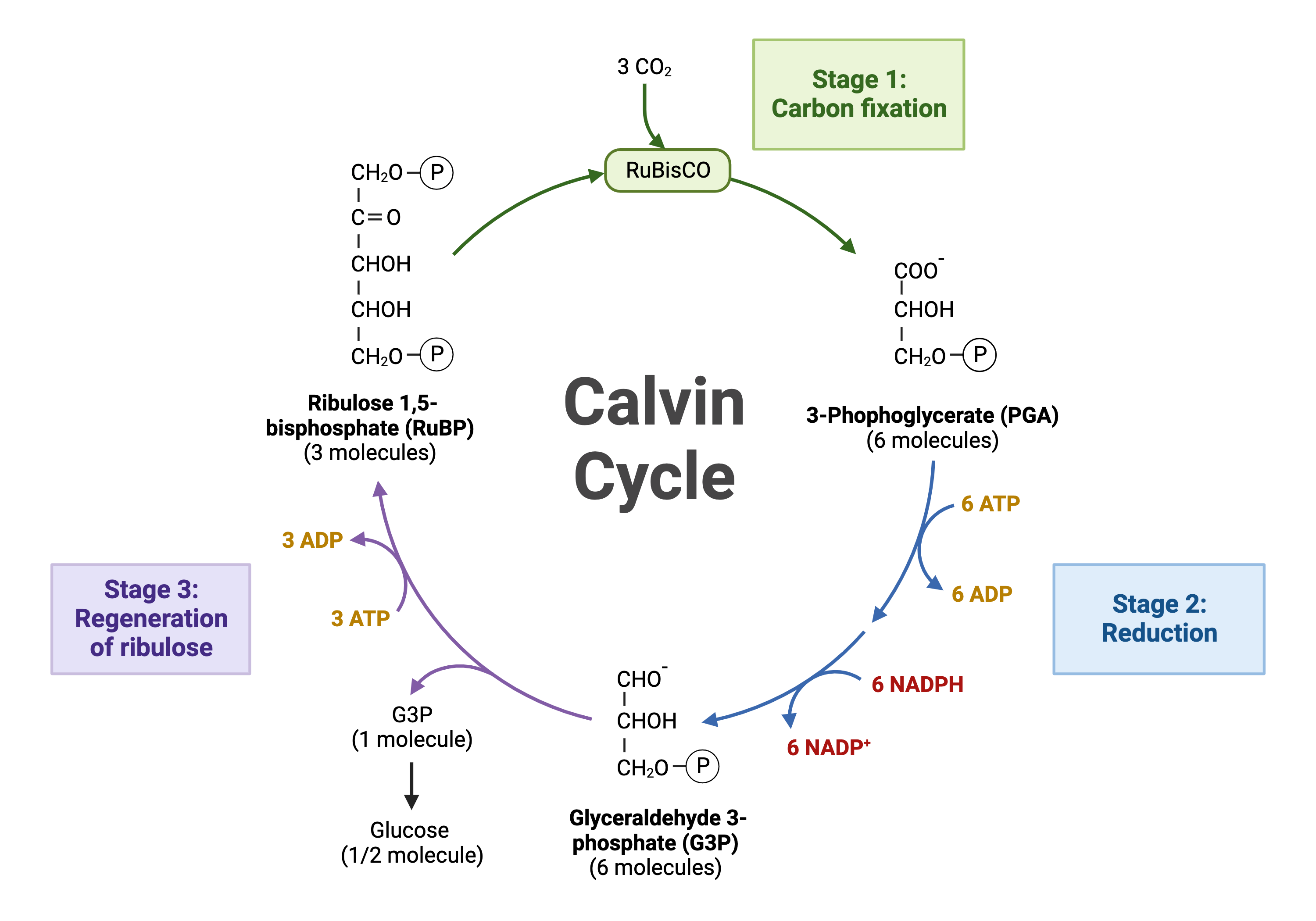24.4 The Calvin Cycle
After the energy from the sun is converted into chemical energy and temporarily stored in ATP and NADPH molecules, the cell has the fuel needed to build carbohydrate molecules for long-term energy storage. The products of the light-dependent reactions, ATP and NADPH, have lifespans in the range of millionths of a second, whereas the products of the light-independent reactions (carbohydrates and other forms of reduced carbon) can survive almost indefinitely. The carbohydrate molecules made will have a backbone of carbon atoms. But where does the carbon come from? It comes from carbon dioxide—the gas that is a waste product of respiration in microbes, fungi, plants, and animals. The Calvin cycle is the term used for the reactions of photosynthesis that use the energy captured by the light-dependent reactions to form glucose and other carbohydrate molecules.
The Calvin Cycle
In plants, carbon dioxide (CO2) enters the chloroplast through the stomata and diffuses into the stroma of the chloroplast—the site of the Calvin cycle reactions where sugar is synthesized. The reactions are named after the scientist who discovered them, and reference the fact that the reactions function as a cycle.
The Calvin cycle reactions can be organized into three basic stages: fixation, reduction, and regeneration. In the stroma, in addition to CO2, two other molecules are present to initiate the Calvin cycle: an enzyme abbreviated RuBisCO, and the molecule ribulose bisphosphate (RuBP). RuBP has five atoms of carbon and a phosphate group on each end.

RuBisCO (ribulose-1,5-bisphosphate carboxylase-oxygenase) catalyzes a reaction between CO2 and RuBP, which forms a six-carbon compound that is immediately converted into two three-carbon compounds. This process is called carbon fixation, because CO2 is “fixed” from its inorganic form into organic molecules. RuBisCO may be the most important enzyme on Earth because it is the major enzyme that transforms carbon from inorganic carbon dioxide into a form that can used by living organisms to build biomolecules. RuBisCO is also probably the most abundant protein on Earth.
ATP and NADPH use their stored energy to convert the three-carbon compound, 3-PGA, into another three-carbon compound called G3P. This type of reaction is called a reduction reaction, because it involves the gain of electrons. A reduction is the gain of an electron by an atom or molecule. The molecules of ADP and NADP+, resulting from the reduction reaction, return to the light-dependent reactions to be re-energized.
One out of every six G3P molecules produced during carbon reduction leaves the Calvin cycle to contribute to the formation of carbohydrate molecules, which is commonly glucose (C6H12O6). Because glucose has six carbon atoms, it takes six turns of the Calvin cycle to make this carbohydrate molecule (one for each carbon dioxide molecule fixed). The remaining G3P molecules regenerate RuBP, which enables the system to prepare for the carbon-fixation step. Energy released by ATP hydrolysis is also used in the regeneration of RuBP.
Respiration and Photosynthesis: the reactions that sustain the biosphere
Whether the organism is a bacterium, plant, or animal, all living things access energy by breaking down carbohydrate and other carbon-rich organic molecules. Living things need energy to perform life functions. In addition, an organism can either make its own food or eat another organism—either way, the food still needs to be broken down. Finally, in the process of breaking down food, called cellular respiration, heterotrophs release needed energy and produce “waste” in the form of CO2 gas.
In reality, CO2 is no more a form of waste than oxygen is a waste product of photosynthesis. Both are byproducts of reactions that move on to other reactions. Photosynthesis absorbs light energy to build carbohydrates in chloroplasts, and aerobic cellular respiration releases energy by using oxygen to metabolize carbohydrates in the cytoplasm and mitochondria. Both processes use electron transport chains to capture the energy necessary to drive other reactions. These two powerhouse processes, photosynthesis and cellular respiration, function in biological harmony to allow organisms to access life-sustaining energy that originates millions of miles away in a burning star humans call the sun.
light-independent reactions of photosynthesis that convert carbon dioxide from the atmosphere into carbohydrates using the energy and reducing power of ATP and NADPH
ribulose-1,5-bisphosphate carboxylase-oxygenase; the enzyme that fixes carbon from the atmosphere and binds carbon dioxide to RuBP

